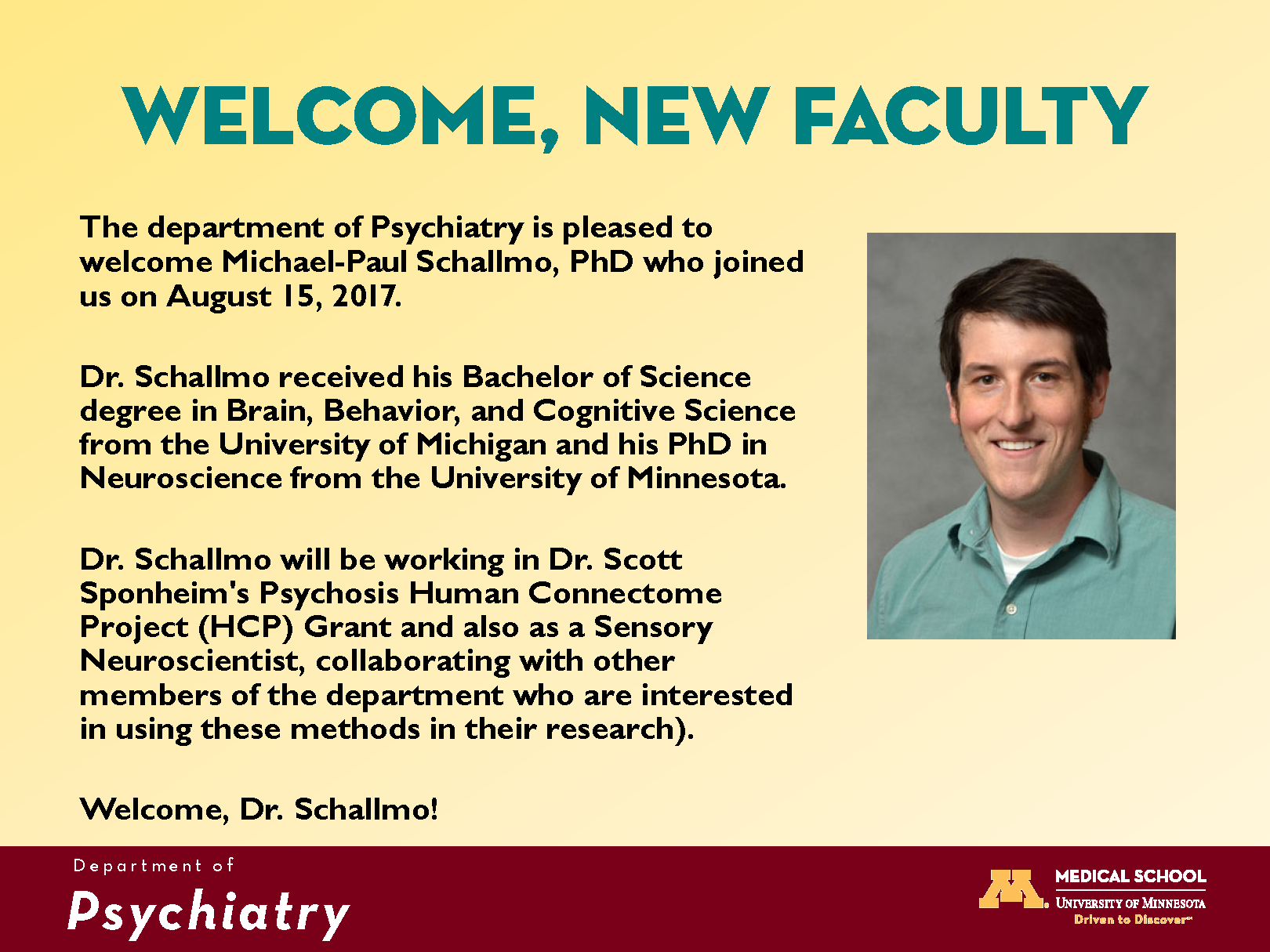
Preprint submitted for Visual Perception in Visual Snow Syndrome
May 23rd, 2023
Lam members Sam Montoya, Carter Mulder, and Dr. Schallmo alongside co-authors Dr. Mike Lee and Dr. Stephen Engel have submitted a manuscript as part of the ongoing study within the lab, Visual Perception in Visual Snow Syndrome (VPVSS). See below for the link to the preprint
https://doi.org/10.31234/osf.io/mde2y
See the publications page for the full citation!
Recent Publication in NeuroImage
May 15th, 2023
Schallmo lab members recently published a paper in NeuoImage describing the methods and data quality from 7 T task fMRI and MR spectroscopy experiments as part of the Psychosis Human Connectome Project.
https://doi.org/10.1016/j.neuroimage.2023.120060
See the publications page for the full citation!
Society for Neuroscience
November 10th-17th
Samantha Montoya presented her research on Visual Snow Syndrome (VSS) at the Society for Neuroscience in San Diego, CA. Sam discussed how the Schallmo lab is measuring VSS through psychophysics.
Montoya, S., Lee, M., Mulder, C., Engel, S., Schallmo, M-P (2022, November). A New Method for Measuring Visual Snow Symptoms. Poster presentation at Society for Neuroscience in San Diego, CA.
University of Buffalo Cognitive Science Colloquium

November 9th, 2022
Dr. Schallmo gave an invited talk on Altered states of visual consciousness: Comparing psychosis and psilocybin at the University of Buffalo Cognitive Science Colloquium in Getzville, NY.
See the abstract below:
Both psychotic disorders and hallucinogenic drugs can have profound effects on visual perception, but the neural basis of these phenomena remains unknown. Because of the vivid hallucinations that are induced, some have theorized that psychedelic drugs such as psilocybin (i.e., magic mushrooms) produce a psychotic-like state in the brain. However, due to prohibition and stigma over the last 50 years, relatively little is known about the precise effects of psilocybin on visual functioning. One aspect of visual perception that may be particularly affected in both psychotic and psychedelic states is context processing, or the influence of surrounding objects on the appearance of a target (e.g., camouflage). We and others have shown that people with psychosis spectrum disorders (i.e., schizophrenia and bipolar disorder) report weaker effects of surrounding context during perception of a visual illusion known as surround suppression. In this talk, I will describe what is known about how perception of this context illusion differs among people with psychosis from previous and ongoing work in my laboratory. In addition, I will present results from our placebo-controlled pilot study (n = 6) examining the effects of psilocybin on visual context perception, and I will draw comparisons between these two altered states of visual consciousness. Although both can induce visual hallucinations, our findings suggest that psychosis and psilocybin may have profoundly different effects on neural and perceptual functioning during visual context perception.
Optica Fall Vision Meeting
October 20th-23rd, 2022
Samantha Montoya presented her ongoing research on Visual Snow Syndrome, Quantifying Visual Snow Symptoms with a Matching Task, at the Optica Fall Vision Meeting in Rochester, NY. See the abstract and poster below.
Montoya, S., Lee, M., Mulder, C., Engel, S., Schallmo, M-P (2022, October). Quantifying Visual Snow Symptoms with a Matching Task. Poster presentation at the Optica Fall Vision Meeting in Rochester, NY.
See the abstract below:
The primary symptom of Visual Snow Syndrome (VSS) is a veil of dots/static flickering across the entire visual field. VSS is a serious but poorly understood disorder (prevalence 1.4-3.3%). Symptoms of VSS can interfere with daily tasks like driving and reading. However, few studies have examined VSS, and quantitative measurements of symptoms are lacking. We developed a matching task in which participants with VSS adjusted parameters of simulated visual snow on a computer screen; participants modified the contrast, density, speed, and size of an array of dots to match their visual snow. Simulated snow was generated by random independent draws from a binary distribution controlled by the contrast parameter. Snow density was adjusted by setting a proportion of pixels equal to the background luminance. The speed setting determined the lifetime of each snow element, after which it was replaced. Dot size was adjusted by moving closer or further from the display and recording the viewing distance, as perceived snow elements were generally smaller than one pixel viewed from 0.5 m. Individuals with VSS said the simulated snow closely resembled their perceived snow, and parameter settings were consistent across trials. Simulated snow contrast settings were relatively low and dot size was relatively small. This task provides a quantitative assessment of visual snow percepts, which may facilitate assessment of treatments/therapies and testing of hypotheses about underlying mechanisms.
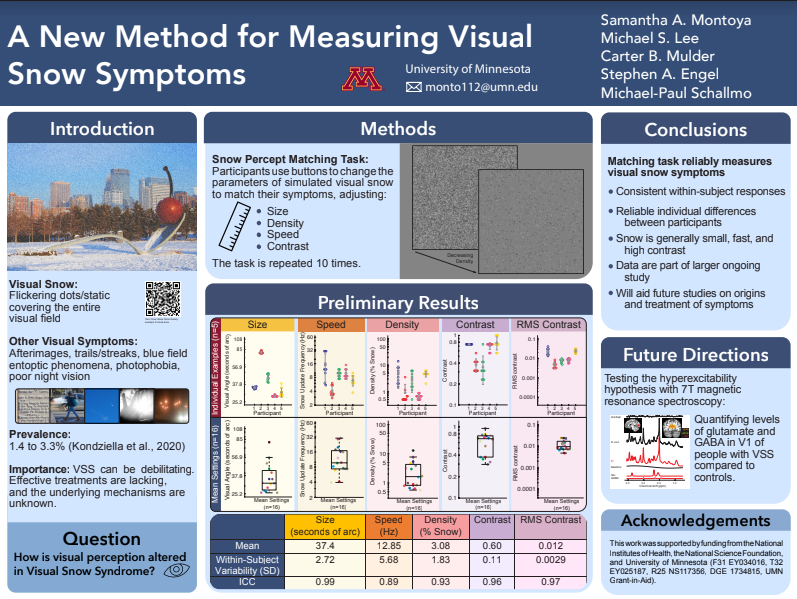
Pre-Print Posted in medRxiv
September 18th, 2022
Schallmo, M-P., Weldon, K.B., Kamath, R.S., Moser, H.R., Montoya, S.A., Killebrew, K.W., Demro, C., Grant, A.N., Marjańska, M., Sponheim, S.R., Olman, C.A. (submitted). The Psychosis Human Connectome Project: Design and rationale for studies of visual neurophysiology. Preprint available on medRxiv.
Carter Mulder Joins Lab
June 6th, 2022
Carter Mulder has officially joined the Schallmo Lab as a full time researcher. To learn more about Carter, visit his biography page here.
Vision Sciences Society
May 13th-18th, 2022
Members of the Schallmo Lab presented their research, in person, at this year's annual Vision Science Society (VSS) meeting at St. Pete Beach, FL:
Schallmo, M-P., Weldon, K.B., Kamath, R.S., Moser, H.R., Montoya, S.A., Killebrew, K.W., Demro, C., Grant, A.N., Marjańska, M., Sponheim, S.R., Olman, C.A. (2022, May). Studies of visual neurophysiology in the psychosis Human Connectome Project. Poster presented at the Vision Sciences Society Meeting, St. Pete Beach, FL.
Killebrew, K.W., Moser, H.R., Grant, A.N., Sponheim, S.R., Schallmo, M-P. (2022, May). Investigating the relationship between blinks, saccades, and bistable percepts during a structure-from-motion task in patients with psychosis. Poster presented at the Vision Sciences Society Meeting, St. Pete Beach, FL.
Montoya, S.A., Lee, M.S., Engel, S.A., Schallmo, M-P. (2022, May). A new method for measuring visual snow symptoms. Poster presented at the Vision Sciences Society Meeting, St. Pete Beach, FL.
Travel Award from SOBP
April 27th-30th, 2022
Dr. Schallmo received a Travel Award from the Society of Biological Psychiatry (SOBP) to attend SOBP's Meeting in New Orleans, LA.
Schallmo, M-P., Weldon, K.B., Kamath, R.S., Moser, H.R., Montoya, S.A., Killebrew, K.W., Demro, C., Grant, A.N., Marjańska, M., Sponheim, S.R., Olman, C.A. (2022, April). The psychosis Human Connectome Project: Studies of visual processing. Biological Psychiatry, 91(9), S321, Poster presented at the Society of Biological Psychiatry Meeting, New Orleans, LA.
Travel award from ACNP
December 4th-8th, 2021
Dr. Schallmo received a Travel Award from the American College of Neuropsychopharmacology to attend their 2021 annual meeting in San Juan, PR. He presented the following poster:
Schallmo, M-P., Moser, H.R., Marjańska, M., Sponheim, S.R. (2021, December). Impaired contrast gain control in psychosis. Poster presented at the American College of Neuropsychopharmacology Meeting, San Juan, Puerto Rico.
Paper published in Human Brain Mapping
June 22nd, 2021
Dr. Schallmo and colleagues published a paper entitled Assessing methods for geometric distortion compensation in 7 T gradient echo functional MRI data in Human Brain Mapping.
Vision Sciences Society
May 21st-26th, 2021
Members of the Schallmo Lab presented their work at the (virtual) Vision Sciences Society meeting:
Kamath, R.S., Weldon, K.B., Moser, H.R., Burton, P.C., Sponheim, S.R., Olman, C.A., Schallmo, M-P. (2021, May). Representational similarity analysis of 7T fMRI data suggests disorganized contour processing in psychosis. Poster presented at the virtual Vision Sciences Society Meeting.
Killebrew, K., Demro, C., Sponheim, S.R., Marjańska, M., Schallmo, M-P. (2021, May). Can neurochemical concentrations in the visual cortex differentiate patients with psychosis from healthy controls via multivariate decoding? Poster presented at the virtual Vision Sciences Society Meeting.
Montoya, S., Moser, H., Sponheim, S., Engel, S., Schallmo, M-P. (2021, May). Multi-voxel pattern analysis of center-surround processing in psychosis. Poster presented at the virtual Vision Sciences Society Meeting.
Moser, H.R., Chong, L.S., Kamath, R.S., Sponheim, S.R., Schallmo, M-P. (2021, May). Contrast surround suppression in people with psyhosis: A behavioral and 7 tesla fMRI study. Poster presented at the virtual Vision Sciences Society Meeting.
Outreach: Brain2Brain Livestream
October 14th, 2020
Dr. Schallmo participated in a UMN Bell Museum Facebook Live event discussing how we and our collaborators use MRI to study the human brain. Watch the replay on YouTube.
Vision Sciences Society
June 19th-24th, 2020
Members of the Schallmo Lab presented their work at the (virtual) Vision Sciences Society meeting:
Schallmo, M-P., Moser, H.R., Demro, C., Marjańska, M., Sponheim, S.R. (2020, June). The role of GABA during visual contrast perception in psychosis. Poster presented at the virtual Vision Sciences Society Meeting.
Kamath, R.S., Weldon, K.B., Sanchez, M.J., Olman, C.A., Sponheim, S.R., Schallmo, M-P. (2020, June). Contour-object perception in psychosis. Poster presented at the virtual Vision Sciences Society Meeting.
Killebrew, K.W., Moser, H.R., Sponheim, S.R., Schallmo, M-P. (2020, June). Faster switch rates in psychosis for bi-stable perception during a structure-from-motion task. Poster presented at the virtual Vision Sciences Society Meeting.
Moser, H.R., Chong, L.S., Sanchez, M.J., Sponheim, S.R., Schallmo, M-P. (2020, June). Visual contrast processing in people with psychosis. Poster presented at the virtual Vision Sciences Society Meeting.
International Symposium on GABA and Advanced MRS
November 20th, 2019
Dr. Schallmo presented a talk on the role of GABA in visual contrast perception at the 5th International Symposium on GABA and Advanced MRS in Park City, UT.
Schallmo, M-P., Demro, C., Moser, H.R., Sponheim, S.R. Marjańska, M. (2019, November). GABA and visual contrast perception in psychosis. Talk presented at the International Symposium on GABA and Advanced MRS, Park City, UT.
Society for Research in Psychopathology Poster
September 19th, 2019
Rohit Kamath presented a poster entitled "Impaired contour-object perception in psychosis" at the 2019 Society for Research in Psychopathology Meeting in Buffalo, NY.
Kamath, R., Grant, A.N., Olman, C.A., Sponheim, S.R., Schallmo, M-P. (2019, September). Impaired contour-object perception in psychosis. Poster presented at the Society for Research in Psychopathology Meeting, Buffalo, NY.
Staff comings and goings
July 11th, 2019
The Schallmo Lab welcomes Dr. Kyle Killebrew and Dr. Hannah Moser to our team! In June, Kyle joined us as a post-doctoral associate and Hannah joined us as a researcher.
RA, Jesslyn (Li Shen) Chong, will be leaving in July to attend graduate school at SUNY Albany. We wish her the best of luck!
Pre-print available for "Weaker neural suppression in autism"
May 26th, 2019
Dr. Schallmo's first-authored paper on "Weaker neural suppression in autism" is now available online as pre-print. Click here to read more about it.
International Society for Autism Research meeting 2019 Poster Presentation
May 4th, 2019
Dr. Schallmo presented a poster entitled "Weaker neural suppression during visual perception in autism spectrum disorder" at the International Society for Autism Research meeting in Montreal, Canada.
Abstract:
Background
It has been proposed that autism spectrum disorder (ASD) is associated with an imbalance of excitation and inhibition. While this is supported by specific animal models of ASD, there is little direct experimental support for this hypothesis from studies in humans.
Objectives
Using a visual motion paradigm, we tested whether mechanisms that regulate neural activity may be disrupted among individuals with ASD.
Methods
Within the visual system, a powerful suppressive regulatory effect occurs in neurons when a stimulus is presented that is larger than that neuron’s classical receptive field – information from the surround suppresses the neural response to the stimulus in the center. We used a well-known behavioral paradigm that reflects this spatial suppression by measuring the amount of time required to perceive the motion direction of stimuli at various sizes. In addition, we used fMRI to measure neural suppression in the motion sensitive brain area called human MT complex (hMT+). We further tested the mechanism of this suppression by measuring levels of the inhibitory neurotransmitter GABA in the hMT+ region using MR spectroscopy. Participants included 28 young adults with ASD (10 male, 8 female) with diagnoses confirmed through ADOS, ADI and clinical judgment using DSM-5 criteria, as well as 35 age-, gender-, and IQ- matched neurotypical controls (21 male, 14 female).
Results
In both the behavioral and fMRI measurements, we found strong evidence of reduced suppression among young adults with ASD compared to neurotypical controls (Supplemental Figures 1 & 2). However, MR spectroscopy measurements in the region of hMT+ showed no difference in GABA levels between ASD and control groups.
Conclusions
Our results suggest that differences in suppressive regulatory mechanisms in ASD reflect changes in neural activity, but are not driven by a specific difference in GABA concentration.
Invited Talk: University of Nevada, Reno Psychology-Cognitive & Brain Sciences and Neuroscience Speaker Series
April 19th, 2019
Dr. Schallmo gave an oral presentation on "Weaker Neural Suppression in Autism" at the University of Nevada, Reno Psychology Cognitive & Brain Sciences and Neuroscience Speaker Series.
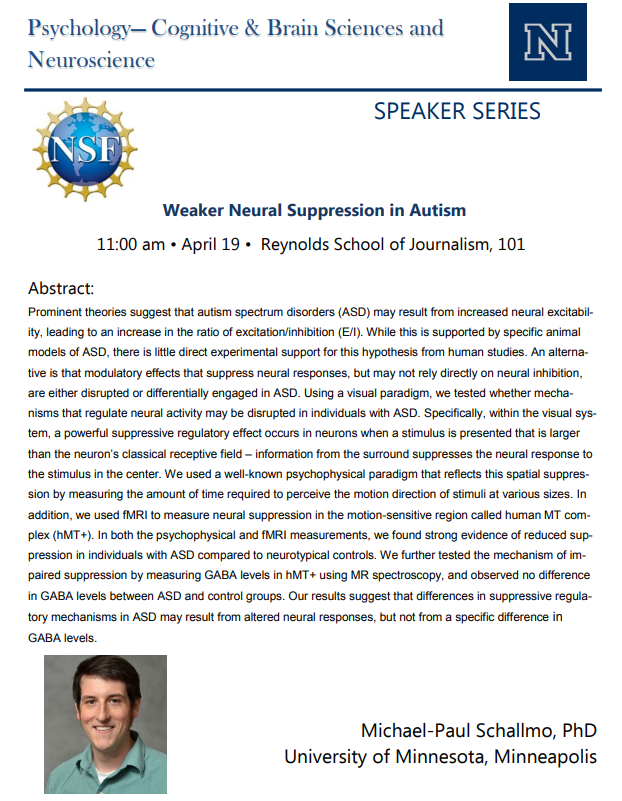
Schizophrenia International Research Society Congress 2019 Poster Presentation
April 13th, 2019
Dr. Schallmo presented a poster entitled "Impaired visual contrast perception in psychosis" at the Schizophrenia International Research Society Congress in Orlando, FL.
Invited Talk: UMN 8th Annual Spring Vision Research Symposium
April 5th, 2019
Dr. Schallmo gave an oral presentation on "Weaker Neural Suppression in Autism" at the University of Minnesota 8th Annual Spring Vision Research Symposium.
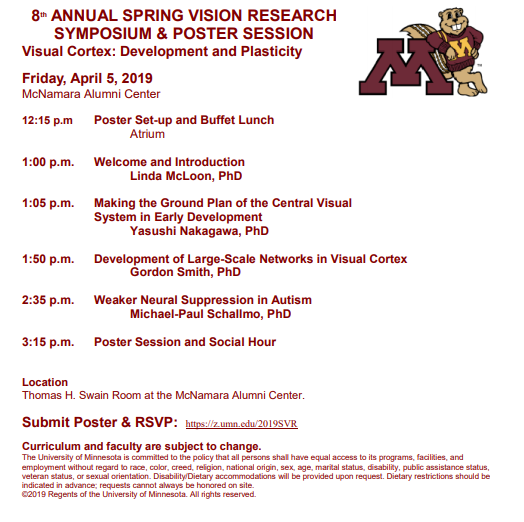
Invited Talk: UMN Graduate Program in Neuroscience Colloquium Series
January 23rd, 2019
Dr. Schallmo gave an oral presentation on "A Specific Reduction of Neural Suppression in Autism." at the University of Minnesota Graduate Program in Neuroscience Colloquium Series.
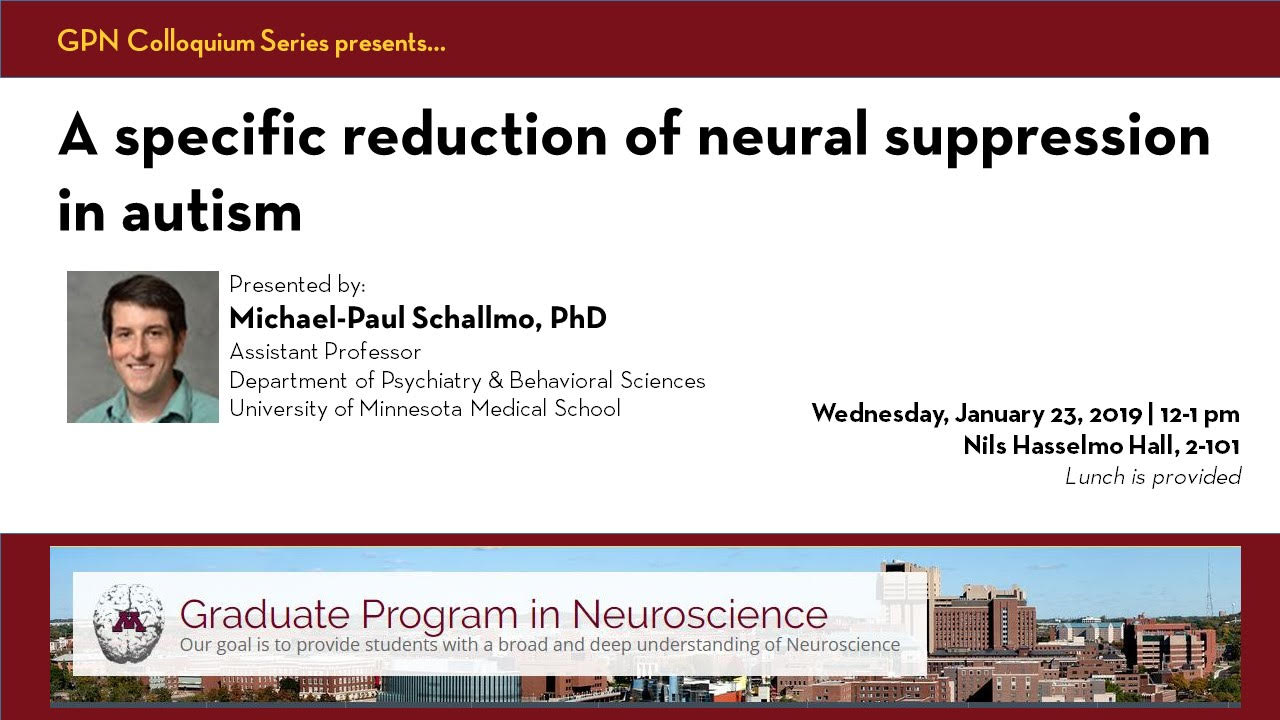
Hiring Now: Post-doctoral Position in the Visual Neuroscience of Psychopathology
December 10th, 2018
Schallmo Lab is looking to hire a post-doctoral researcher in the Department of Psychiatry and Behavioral Science at the University of Minnesota, Minneapolis, MN, USA.
**Update: This position is now closed. Thank you for your interest!
Invited Talk: Perception Lunch Colloquium Series Talk
November 28th, 2018
Dr. Schallmo gave an oral presentation on Visual motion processing in neuro-typical adults and those with autism spectrum disorders at the Perception Lunch Colloquium Series, Department of Psychology, University of Minnesota.
"Visual motion processing in neuro-typical adults and those with autism spectrum disorders"
Abstract:
I'll be talking about our recent work looking at the neural basis of a well-known motion perception phenomenon, wherein larger stimuli are more difficult to perceive. This effect is of particular interest, because we have found it is abnormally weak among people with autism spectrum disorders. I will present findings from studies using 5 different methods (behavioral psychophysics, computational modeling, functional MRI, pharmacology, and MR spectroscopy) to reveal the neural processes underlying this effect, and the impact of autism.
Society for Neuroscience 2018 Poster Presentation
November 4th, 2018
Dr. Schallmo presented a research poster titled Glutamatergic facilitation of neural responses in area MT enhances visual motion perception in humans at the Society for Neuroscience November 2018 meeting in San Diego, CA.
"Glutamatergic facilitation of neural responses in area MT enhances visual motion perception in humans"
Michael-Paul Schallmo1*, Rachel Millin1, Alex M. Kale1, Tamar Kolodny1 , Richard A.E. Edden 2, Raphael A. Bernier3 & Scott O. Murray1
1 Department of Psychology, University of Washington, Seattle, WA
2 Department of Radiology and Radiological Science, Johns Hopkins University, Baltimore, MD
3 Department of Psychiatry and Behavioral Sciences, University of Washington, Seattle, WA
Abstract:
There is large individual variability in human neural responses and perceptual abilities. The factors
that give rise to these individual differences, however, remain largely unknown. To examine these
factors, we separately measured fMRI responses to moving gratings in the motion-selective region MT,
and perceptual duration thresholds for motion direction discrimination within the same group of male
and female subjects. Further, we acquired MR spectroscopy data that allowed us to quantify an index of
neurotransmitter levels in the region surrounding MT. We show that stronger Glx (glutamate +
glutamine) signals in the MT region are associated with both higher fMRI responses and improved
psychophysical task performance. Our results suggest that greater baseline levels of glutamate within
MT facilitate motion perception by increasing neural responses in this region.
Invited Talk: Vision Sciences Society Meeting 2018
May 20th, 2018
Dr. Schallmo gave an oral presentation on Weaker neural suppression in autism spectrum disorder at the Vision Sciences Society Meeting May 2018.
"Weaker neural suppression in autism spectrum disorder"
Michael-Paul Schallmo1,2, Alex M Kale2, Tamar Kolodny2, Rachel Millin2, Raphael A Bernier3, Scott O Murray2
1 Department of Psychiatry, University of Minnesota
2 Department of Psychology, University of Washington
3 Department of Psychiatry and Behavioral Science, University of Washington
Abstract:
Autism spectrum disorder (ASD) is often hypothesized to stem from a dysregulation of neural activity resulting in an imbalance of excitation and inhibition. While this is supported by specific animal models of ASD, there is little direct experimental support for this hypothesis from human studies. Using a visual paradigm, we tested whether mechanisms that regulate neural activity may be disrupted in individuals with ASD. Specifically, within the visual system, a powerful suppressive regulatory effect occurs in neurons when a stimulus is presented that is larger than the neuron’s classical receptive field – information from the surround suppresses the neural response to the stimulus in the center. We used a well-known psychophysical paradigm that reflects this spatial suppression by measuring the amount of time required to perceive the motion direction of stimuli at various sizes. In addition, we used fMRI to measure neural suppression in the motion sensitive region called human MT complex (hMT+). In both the psychophysical and fMRI measurements, we found strong evidence of reduced suppression in individuals with ASD compared to neurotypical controls. We further tested the mechanism of impaired suppression by measuring GABA levels in hMT+ using MR spectroscopy, and observed no difference in GABA levels between ASD and control groups. Our results suggest that differences in suppressive regulatory mechanisms in ASD may result from altered neural responses, but not from a specific difference in GABA levels.
Society for Neuroscience 2017 Poster Presentation
November 14th, 2017
Dr. Schallmo presented a research poster titled Suppression and Facilitation of Neural Responses in the Human Visual System at the Society for Neuroscience November 2017 meeting in Washington, D.C.
"Suppression and facilitation of neural responses in the human visual system"
Schallmo, M-P., Kale, A.M., Millin, R., Flevaris, A.V., Bernier, R.A., Murray, S.O.
Abstract:
Neural suppression and facilitation regulate levels of activity within the brain, but how these effects are mediated remains poorly understood. Both reduced and enhanced neural responses are well-known to emerge in the visual system via spatial context effects, and have a variety of perceptual consequences. For example, the perception of visual motion has been reliably shown to depend on the size and contrast of a stimulus. Specifically, more time is needed to discriminate the direction of motion of a large high contrast grating compared to one that is small. This seemingly paradoxical effect is referred to as spatial suppression, and has been suggested to reflect neural suppression from extra-classical receptive field surrounds. The effect of size on duration thresholds is reversed for a low contrast stimulus – less time is needed to discriminate motion direction for a large compared to small stimulus (spatial summation). Strong assumptions are often made about the neural processes underlying these seemingly complex interactions between size and contrast during motion perception. For example, it is often assumed that spatial suppression and summation reflect distinct neural mechanisms that rely on inhibitory and excitatory processes, respectively, within brain regions involved in visual motion processing (particularly area MT).
We tested these assumptions directly using a multi-modal approach that combined five different techniques: functional MRI (fMRI), magnetic resonance spectroscopy (MRS), pharmacology, quantitative behavioral analysis (psychophysics), and computational modeling. We show that: 1) spatial suppression and summation in fact naturally emerge from a single, well-established neural computation known to occur in visual cortex – divisive normalization; there is no need to posit separate mechanisms. 2) While neural responses in human MT complex (hMT+) indexed with fMRI provide better correspondence with the measured perceptual effect, there is substantial suppression in earlier visual areas. 3) Two separate methodologies – magnetic resonance spectroscopy (MRS) and pharmacological potentiation of GABA A receptors – demonstrate that spatial suppression is not directly linked to neural inhibition. While we find that inhibition plays a role in motion perception, increases in duration threshold as a function of stimulus size should not be taken as an index of inhibitory processing. In total, our results suggest that a single computational principle – divisive normalization – can account for spatial context effects, and that suppressive context effects are not driven by neural inhibition.
Dr. Schallmo Joins the Department of Psychiatry
August 15th, 2017
